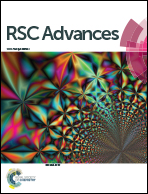Reduction mechanism of iron titanium based oxygen carriers with H2 for chemical looping applications – a combined experimental and theoretical study†
Abstract
The reduction mechanisms of three iron titanium based oxygen carriers with H2 have been investigated by experimental and theoretical methods for the chemical looping process. The oxygen carriers have been successfully prepared and the initial rate for the reduction reactions has been predicted as a function of initial molar concentration of Fe2TiO5, Fe2TiO4 and FeTiO3 at different temperatures from 800 to 1000 °C. Density functional theory calculations have been used to explain the reduction mechanism of oxygen carriers with H2. Our results show that the reduction of Fe2TiO5 with H2 has the smallest activation energy compared with the others. The observed rate constant values indicate that the reduction mechanism of Fe2TiO5 is much faster than that of the others. Also, we found that the diffusion of a H atom from Fe is the rate determining step for the reduction of the three iron titanium oxygen carriers. Additionally, the experimentally predicted activation energies are in good agreement with the theoretical values.



 Please wait while we load your content...
Please wait while we load your content...